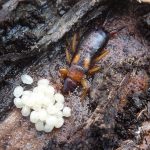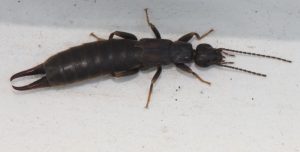
Earwigs in Melbourne
Earwigs are small insects easily distinguished from other insects by a pair of forcep or pincer-like cerci at the end of the abdomen. Earwigs are widely distributed throughout Australia. They include native and introduced species. There are over 1,000 species of earwigs with 85 species of Australian earwigs currently identified, (with up to that number again estimated still to be described).
EPC – Enviro Pest Control provide Earwig treatments in Melbourne for commercial and domestic clients.
- General Earwig facts

- Approx. 5-25 mm long although some species can grow to 50 mm long
- Nocturnal so mostly active at night but are attracted to lights at night
- Omnivorous – they will eat both plant and animal material
- Prefer protected, moist environments in leaf litter and all kinds of debris on the ground, under bark, stones and pot plants, between leaves and inside flowers
- Body is elongated and flattened or cylindrical
- They can be winged or wingless
- Many species of earwig are particularly partial to pollen
- Love humidity and dampness
- Come in a range of colours including yellow, yellow brown, orange brown, reddish brown, dark brown and black, and sometimes are a combination of these
- The abdomen is long, flexible and telescopic (segments of the abdomen may be drawn into one another like a telescope)
- Some species produce a foul smelling liquid that they use for defence
Earwig species most commonly found in Melbourne by EPC – Enviro Pest Control are:
- European Earwig (Forficula auricularia)
- Introduced pest species. Been in Australia since the 1850’s
- Approx.12-24 mm long
- Pincers of male earwigs are long and curved while those of females are almost straight.
- Females lay batches of 20-80 white oval eggs in burrows in the topsoil
- Young earwigs, also called nymphs, look similar to adults but are smaller, paler and do not have wings
- 2 generations per year. One breeding cycle in late winter/early spring and a second in summer
- Although they have wings they seldom fly
- Can damage crops and contaminate grains
- Common Brown Earwig (Labidura truncata)
- Native species
- Has similar colouring to European earwig.
- Can be distinguished from European earwig by presence of orange triangle behind the head on the wing case.
- (Carcinophora occidentalis -no common name)
- Native species
- Have reddish brown foreparts and legs with a darker abdomen and pincers.
- Often solitary and will not be seen in the high numbers associated with the European Earwigs
Breeding and Life Cycle of Earwigs
The earwig lifecycle is an incomplete metamorphosis. This means that when the nymphs are hatched, they look like an adult, save for a few characteristics. Their pincers are noticeably smaller and more underdeveloped, as compared to the adults. Young pincher nymphs also lack wings and there’s a noticeable line going through their entire heads and bodies where the cuticle splits when the nymphs moult. It is not seen on the final adult form.
Females can be readily distinguished from males as they are usually smaller, have simple forceps and eight visible abdominal (hind-body) segments as opposed to males, which have ten.
A female can lay 40 to 50 eggs at a time in a short burrow she has created and designated for this specific purpose. They take a week to hatch. Length of the lifecycle depends on temperature.
Female earwigs care for their eggs and young nymphs, which is an unusual trait in most non-social insects. They defend eggs from intruders and care for the eggs by collecting them up if they become scattered, cleaning the eggs by licking off fungus and parasites.
Nymphs moult four to five times before becoming an adult. The mother stops caring for them by the third, at which point she might eat them.
Signs of Earwig presence
If you find you have more than a few individual pincher bugs, you probably have an earwig infestation, so call EPC – Enviro Pest Control today.
Earwigs don’t transmit diseases. They are completely harmless. Their pincers aren’t powerful enough to produce a strong pinch.
They can bite, but the bites only cause minor irritation. Pincher bugs really look more dangerous than they actually are.
EPC’s Fun facts about Earwigs
- There is family of earwigs, (Arixeniidae), which parasitize bats
- Male earwigs find mates using their sense of smell
- Earwigs got their name from the myth that they crawl into sleeping people’s ears and tunnel into their brains
- If you see a white earwig these are just recently moulted individuals whose exoskeleton has not hardened and taken on the normal colourations
- Like cockroaches, earwigs are thigmotactic which means they cannot rest comfortably unless both upper and lower surfaces of their bodies are touching something
Why Hire EPC – Enviro Pest Control To Remove Earwigs?
At EPC – Enviro Pest Control we have a lot of experience when it comes to earwig treatments in Melbourne. If you notice that the number of earwigs you see is increasing, there is a chance that there might be a nest around or in your property. EPC will inspect your home and inspect your business building and treat the infestation to a control and elimination service. Other reasons to hire us as your Earwig treatment service are:
- EPC – Enviro Pest Control staff are Trained Specialists and are experienced at getting rid of earwigs and understand the importance of a fast, efficient solution
- We arrive on time
- EPC – Enviro Pest Control staff are discreet, friendly and professionally presented
- Fairly priced service with advice to help prevent earwigs coming back
- EPC – Enviro Pest Control pest control services including earwigs are effective
If you need to speak to a professional about Earwig Treatments in Melbourne, call 03 9988 5066 now.
